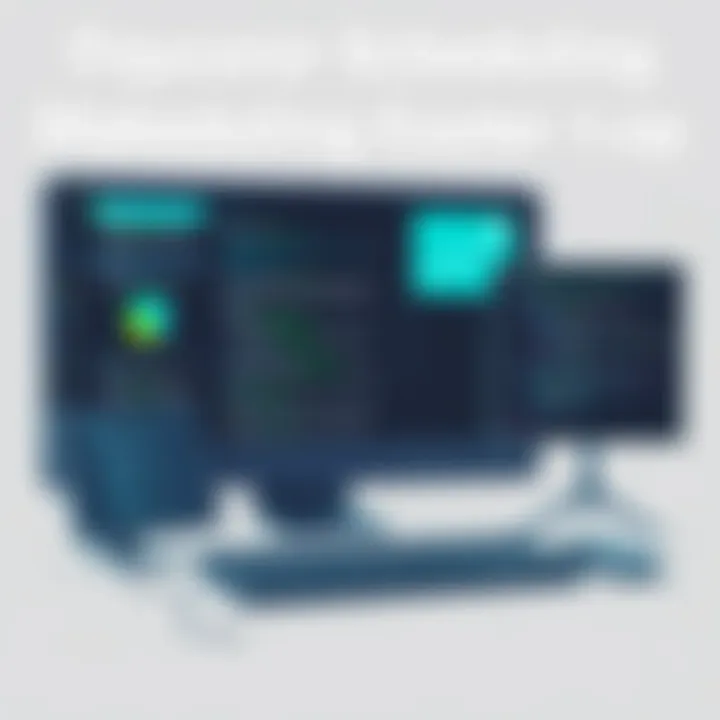Exploring Paycor Scheduling Software Capabilities


Intro
In the rapidly evolving landscape of workforce management, having the right scheduling tools can make or break a business's efficiency. Paycor Scheduling Software offers a promising solution for organizations looking to optimize their scheduling processes. This article delves into the intricate details of Paycor's offerings—shedding light on what makes it a valuable asset for managing personnel effectively while also addressing potential pitfalls that come with its implementation.
From small startups trying to organize their shifts to large enterprises with complex staffing needs, the features of Paycor aim to tackle a variety of challenges. By examining its core functionalities, user experience, and technical specifications, businesses can carve out a more informed path towards enhancing productivity through better scheduling. Let's explore what Paycor has to offer and how it shapes the experience of workforce management.
Preamble to Paycor Scheduling Software
In today's fast-paced business landscape, effective workforce management is paramount. With the rise of remote work and flexible schedules, companies are now grappling with complex scheduling needs. This is where Paycor Scheduling Software comes into play, serving as an essential tool for organizations of all sizes. The importance of such software cannot be overstated. It simplifies the intricate task of scheduling employees, ensuring that the right people are in the right place at the right time without unnecessary overlaps or gaps.
Overview of Workforce Scheduling Needs
Understanding workforce scheduling needs is like peeling an onion; it has many layers, each revealing different aspects of operational efficiency. Companies often struggle to achieve balance—between employee availability, skill sets, and business demands. It’s not just about filling shifts; it requires a systematic approach to manage labor costs and productivity. For example, a restaurant with fluctuating patron volume must schedule staff based on peak hours while considering employee preferences.
Moreover, many industries must comply with labor laws and regulations that dictate work hours, breaks, and overtime. Organizations need tools that can help them navigate these complex waters while also being user-friendly enough for managers and employees alike. Paycor offers features that address these multifaceted needs, making it a viable solution for workforce management. By automating many scheduling tasks, companies can focus more on strategic objectives rather than tedious administrative work.
Importance of Scheduling Solutions in Business Operations
Scheduling solutions like Paycor Scheduling Software are not merely conveniences; they're pivotal to successful business operations. An efficient scheduling system can serve multiple functions: it fosters employee engagement, monitors performance, and enhances overall operational efficiency.
Without a solid scheduling strategy, businesses often end up wasting resources and frustrating employees with last-minute changes or poorly structured shifts. Here are some key points to consider:
- Enhanced Communication: A quality scheduling tool eases the flow of information between management and staff. Employees can view their schedules, request time off, or swap shifts with colleagues, promoting transparency and reducing confusion.
- Reduced Labor Costs: Crafting shifts manually can lead to overstaffing or understaffing, both of which negatively affect the bottom line. Automated scheduling minimizes these errors, allowing for smarter labor cost management.
- Improved Accountability: With time tracking capabilities, it's easier to monitor attendance and assess performance. This fosters a culture of accountability among employees, as they are more aware of their commitments.
As we dive deeper into the capabilities of Paycor Scheduling Software, the practical implications of these features will become clear, offering readers insights not only into functionality but also into how these tools can significantly enhance their operations.
Key Features of Paycor Scheduling Software
Understanding the key features of Paycor Scheduling Software is pivotal for businesses looking to enhance their workforce management strategies. Each aspect is interwoven with the overall efficiency and usability of the software, serving not just as standalone elements but as part of a cohesive tool that addresses the complexities of scheduling. Let’s delve into some core offerings of this software that set it apart.
User-Friendly Interface
A user-friendly interface is the backbone of any software application, especially in workforce scheduling. Paycor boasts a clean and intuitive design, making it more accessible for users at every skill level. Navigating through the modules feels seamless; options are clearly labeled, which reduces the time employees spend on learning the system. That can be particularly beneficial for those who aren't tech-savvy. With features laid out logically and prompts guiding actions, users typically find themselves engaged rather than overwhelmed.
Mobile Accessibility
In today’s fast-paced environment, mobility isn’t just an option; it’s a necessity. Paycor’s mobile accessibility ensures that employees can check their schedules, request time off, or amend their availability from anywhere, at any time. This availability caters to a workforce that increasingly depends on its smartphones to manage work-life balance. If you're a small business, consider how often your staff could utilize this feature during off-hours or in transit. Keeping employees connected to scheduling updates makes it easier for them to adjust on the fly, ultimately promoting efficiency.
Automated Scheduling
Automated scheduling is a game-changer. Paycor's software harnesses algorithms to create and optimize schedules based on employee availability, demand fluctuations, and labor laws, cutting down the time managers spend manually crafting shifts. For instance, if certain shifts are traditionally harder to fill, the software automatically identifies these trends and proposes solutions. This aspect not only saves hours but also limits scheduling conflicts, promoting a smoother operation without manual errors that might arise during human calculations.
Time Tracking Capabilities
Time tracking intertwines closely with scheduling efficiency. Paycor integrates robust time-tracking capabilities that allow employees to clock in and out via mobile or web, aligning their hours with their schedules. This feature not only simplifies payroll processing but helps to ensure employees are compensated accurately.
"Accurate time tracking can eliminate disputes over hours worked, leading to improved employee satisfaction and trust in management."
Additionally, the data generated from time-tracking can be insightful for businesses, enabling them to analyze productivity patterns and make informed staffing decisions.
Integration with HR Systems
Last but not least is the software’s capacity for integration with existing HR systems. This is crucial for businesses that want to maintain a centralized data hub. When scheduling software can communicate seamlessly with HR databases, companies can ensure that information regarding benefits, payroll, and employee records is consistently updated. Thus, staff isn't burdened with the task of maintaining multiple systems to access relevant information, which tends to enhance overall communication across departments.
In summary, Paycor Scheduling Software is crafted to meet the complex demands of workforce management. Its features facilitate not just effective scheduling, but also empower employees, streamline processes, and strengthen integrations with other critical business functions.
Implementation Process
The implementation process of Paycor Scheduling Software is of great significance as it lays the groundwork for how effectively the software will meet a company's workforce scheduling needs. A most effective implementation can mean the difference between smooth sailing and a shipwreck for any organization looking to streamline their workforce management. The steps involved vary, but understanding the nuances of this process can lead to noticeable improvements in overall business performance.
Initial Setup Steps
Setting up Paycor Scheduling Software begins with a clear understanding of your organization's specific needs. The initial steps typically include:
- Define Objectives: Assess what you expect from the software. Are you looking to reduce scheduling conflicts or improve employee transparency?
- Gather Data: Compile necessary information such as employee availability and shift patterns. This often means collecting spreadsheets or existing schedules.
- System Configuration: Customize the software according to your workforce dynamics. Paycor allows for extensive flexibility, so take advantage of its features to align with your business needs.
- Import Data: Upload the collected data into the system. A typical pitfall here is ensuring all formatting is correct to maintain data integrity.
- Test Functionality: Before going live, a thorough testing phase is essential. This step helps identify any technical glitches that could hinder productivity down the road.
These steps, while straightforward, require meticulous attention to detail. A well-set foundation is crucial, as any missteps here can lead to complications later in the process.


Training Requirements
Once the initial setup has taken place, proper training becomes paramount. It’s not just about getting employees to use the software; it�’s about enabling them to harness its full potential. The training requirements include:
- User Training Sessions: Conduct training workshops that focus on different user roles, from management to front-line employees. Taking the time to ensure everyone knows the ins and outs of the software reduces confusion and enhances overall efficacy.
- Continuing Education: Paycor regularly updates its features. Creating a culture of continuous learning around these updates keeps the team informed and engaged.
- Resource Materials: Provide easy access to manuals and video tutorials that users can reference at their convenience. This can prevent bottlenecks in the workflow and empowers employees to solve minor issues independently.
These training requirements are critical as they foster user confidence and competence, making the transition to Paycor Scheduling Software seamless. Without adequate training, the benefits of the software may remain untapped.
User Adoption Strategies
Encouraging user adoption is essential to the successful implementation of Paycor Scheduling Software. To enhance user buy-in, consider these strategies:
- Engage Early: Involve employees in the early stages of implementation. Their input can offer insights into practical needs and foster a sense of ownership.
- Communicate Benefits: Clearly outline how the software improves their daily tasks and the overall workflow. Employees are more likely to embrace changes that promise tangible benefits.
- Continuous Feedback: Set up a feedback loop where users can share their experiences and suggest improvements. This reinforces a sense of community and demonstrates that their opinions matter.
- Incentives for Usage: Encouragement can go a long way. Incentivize the team for milestones achieved with the new system, making it a rewarding experience.
Utilizing these strategies can significantly enhance user acceptance and engagement with the software, leading to a successful integration into daily operations.
Remember: A thoughtful implementation process not only streamlines scheduling but also promotes a better work-life balance for employees.
For more information about effective workforce management strategies, consider exploring resources such as Wikipedia’s article on workforce management and the dedicated forums on Reddit.
Advantages of Using Paycor Scheduling Software
Understanding the benefits of using Paycor Scheduling Software can significantly influence both business outcomes and employee satisfaction. As organizations navigate the complexities of workforce management, this software offers tools that streamline operations effectively. By maximizing efficiency, enhancing employee engagement, and delivering cost-effective solutions, Paycor stands out as a compelling option for those seeking to simplify their scheduling processes.
Increased Efficiency
The ability to optimize workflow is crucial for any business operation. Paycor Scheduling Software does just that. By automating the scheduling process, it minimizes the time spent on manual entry and allows managers to focus on strategic decision-making rather than getting bogged down by repetitive tasks.
- Real-time Updates: The software provides instant updates, ensuring that any last-minute changes to employee schedules are communicated promptly. This feature is invaluable in maintaining operational fluidity.
- Smart Scheduling: Paycor uses algorithms to analyze patterns in employee availability, preferences, and historical data. This ensures that shifts are filled efficiently without overworking staff or causing unnecessary gaps.
Moreover, businesses experience reduced scheduling conflicts, which often leads to fewer missed shifts and increased overall productivity. In this fast-paced environment, goodbye wasted hours!
Improved Employee Engagement
Employee satisfaction hinges greatly on how well their schedules align with personal needs and preferences. With Paycor, employees gain access to a platform that empowers them, fostering an environment of transparency and collaboration.
- Self-Service Options: Employees can view their schedules and request changes through a user-friendly portal. This self-service model enhances engagement as staff feel more in control of their work-life balance.
- Feedback Mechanism: Regularly collected feedback from users enables the software to implement updates based on employee needs, fostering a positive feedback loop. Employees see that their voices are heard, enhancing their overall commitment to the organization.
When employees feel valued and understood, productivity and morale soar. This engagement isn’t just beneficial for the employees; businesses with highly engaged teams often witness dramatic improvements in performance.
Cost-Effectiveness over Time
Investing in robust scheduling software like Paycor can be a game-changer for businesses, impacting the bottom line positively. Though initial costs are a consideration, it's the long-term savings that catch the eye.
- Reduction of Overtime Costs: By using intelligent scheduling, businesses can avoid excess costs associated with overtime. Planned shifts ensure that staff are present without incurring additional payroll expenses.
- Decreased Turnover Rates: Engaged employees are less likely to leave their jobs. Retaining employees leads to lower recruitment and training costs.
In essence, what you invest in Paycor can lead to significant savings down the line, making it a cost-effective solution overall. This kind of efficiency ensures that resources are allocated wisely while still covering quality and employee satisfaction.
"A stitch in time saves nine"—and when it comes to scheduling, this proverb rings true. Put simply, the right scheduling tools can preserve not just resources but also precious employee time.
Challenges and Limitations
While Paycor Scheduling Software offers a plethora of significant benefits, it is also vital to discuss the challenges and limitations that can arise during its implementation and operation. Addressing these elements is crucial for businesses considering this solution, as it allows them to approach the software with a balanced perspective. Understanding potential hurdles means they can devise effective strategies to navigate them successfully.
Technical Limitations
The first notable area of concern lies in the technical limitations of the software. Despite a user-friendly interface, users may encounter issues with specific system requirements that can affect performance. For instance, certain outdated devices or unsupported operating systems might not run the application as intended. Furthermore, businesses operating in niche markets where exceptional features are needed may find the software lacking in certain specialized functionalities.
Some examples include:
- Limited customization options: For organizations with unique scheduling needs, this can result in a one-size-fits-all approach rather than offering specific solutions.
- Integration challenges: While Paycor does assimilate with standard HR systems, integrating with legacy systems often proves to be a cumbersome task, limiting its usability in some environments.
These technical hiccups, if not anticipated, can lead to frustration and misalignment with a business’s overall strategic goals.
User Resistance to Change
Another challenge worth noting is user resistance to change. Introducing new software often means introducing new processes and workflows, which can unsettle employees. People naturally cling to what they know, and shifting towards a new system might be met with apprehension or reluctance.


To mitigate such resistance, organizations must consider:
- Comprehensive training programs: Providing thorough training can ensure employees feel competent and confident in using the software.
- Open communication channels: Keeping dialogue open between management and employees will allow for feedback and create a sense of inclusion in the transition.
This resistance may not only slow down adoption but can also lead to decreased productivity if employees feel disengaged or hesitant to embrace the new tools at their disposal.
Dependence on Internet Connectivity
The final limitation to discuss is the dependence on internet connectivity. Paycor Scheduling Software typically operates in a cloud-based environment, meaning reliable internet access is non-negotiable. Unfortunately, not all companies or remote workers may have consistent connectivity, which can lead to operational disruptions.
Key points to consider include:
- Downtime during outages: As system functionality wanes without connection, staff may struggle to access critical scheduling features.
- Variable speeds: Slow internet can render the software inefficient during peak usage times, becoming a point of contention among users.
Addressing this dependency often requires organizations to invest in reliable internet solutions or develop contingency plans to mitigate any downtime.
In summary, while Paycor Scheduling Software is largely beneficial, recognizing these challenges will enable businesses to be better prepared, ensuring a smoother transition and integration into their operational strategies.
Comparative Analysis with Competitors
Understanding how Paycor Scheduling Software stands up against its rivals is essential for businesses intent on optimizing their workforce management. This section highlights why a comparative analysis of scheduling solutions is a crucial undertaking, discussing specific elements that can influence a business's choice of software.
Importance of Comparative Analysis
In today’s fast-paced corporate environment, choosing the right scheduling software is a matter of both efficiency and productivity. Businesses face unique scheduling challenges, and each software has its own strengths and weaknesses. A comprehensive comparative analysis allows decision-makers to assess how Paycor performs not just in isolation, but against a backdrop of competitive offerings. By evaluating multiple products side-by-side, organizations can identify which features align best with their operational needs, taking into account factors such as user experience, reporting capabilities, and integration with existing systems. Thus, failing to perform this due diligence can lead to increased operational costs and ultimately hinder employee satisfaction.
Key Competitor Overview
When examining competitors to Paycor Scheduling Software, the landscape includes a variety of well-recognized players, each bringing unique features to the table. Some of the notable alternatives include:
- ADP Workforce Now: Renowned for its robust HR capabilities, ADP offers comprehensive payroll and workforce management tools alongside its scheduling functionalities.
- Kronos Workforce Central: Known for its time tracking and labor management solutions, Kronos caters more robustly to larger organizations with complex needs.
- Shiftboard: Focusing on shift scheduling, Shiftboard is a solid choice for industries with dynamic staffing needs.
- Humanity: This tool is designed for flexibility, allowing for rapid changes in scheduling while providing a user-friendly interface for both managers and employees.
These competitors highlight the varied approaches different software solutions adopt toward workforce scheduling. Understanding the landscape aids businesses in discerning not only what they stand to gain with Paycor, but also what they might miss out on compared to other offerings.
Feature Comparison
Doing a feature comparison can lay bare the strengths and weaknesses of Paycor in a manner that helps stakeholders make informed decisions. Here are some crucial features to consider:
- User Interface: How intuitive is the software? Paycor is often praised for its clean user interface, which enables users to navigate easily. Competitors may have similar or more sophisticated features but can sometimes suffer from overwhelming complexity.
- Mobile Access: While Paycor offers strong mobile accessibility, some competitors may provide better offline functionalities or unique mobile-only features that can be crucial in business environments where connectivity is spotty.
- Automated Scheduling: Automated scheduling is a significant advantage of Paycor, but depending on business needs, other solutions might offer more intelligent algorithms for complex workforce environments.
- Integration Capabilities: The ability to link seamlessly with existing software solutions can heavily weigh into a business’s choice. Paycor supports common integrations, but some users might find that tools like Kronos offer more extensive integrations specifically in larger ecosystem environments.
Analyzing these comparisons can reveal where Paycor truly shines and where it might fall short, providing a clear view of its positioning in the market. As businesses look to the future, an informed choice based on comparative analysis lays the groundwork for effective workforce management.
"Without proper analysis of options, a business can easily find itself trapped in a software solution that just doesn't fit"
By assessing both Paycor and its closest competitors, organizations can ensure that they choose the most suitable scheduling solution to meet their specific needs.
User Reviews and Feedback
User feedback, in general, serves as an invaluable compass for businesses assessing software choices like Paycor Scheduling Software. It offers perspectives that often illuminate the user experience beyond mere feature lists or promotional materials. Reading what other users think can save professionals from pitfalls and help them make well-rounded decisions.
Savvy decision-makers appreciate the subjective nature of feedback. They know that the software may work wonders for one organization while falling flat in another due to differences in size, industry, or specific needs. Drawing insights from user reviews can lead to a more tailor-fitted application of the technology to suit unique requirements.
Diving into positive and critical user experiences provides a fuller picture of what to expect. This section illustrates both sides of the coin, settling the assumptions about Paycor Scheduling Software firmly on the ground of real-world applications.
Positive User Experiences
When it comes to positive feedback, many users seem to sing the praises of Paycor Scheduling Software for its intuitive layout and ease-of-use. For instance, a small business owner commented on how, "For a company that juggles multiple staff schedules, the software has turned chaos into calm."
Here are some specific benefits that have caught the attention of users:
- Time-saving Scheduling: Employees have noted that the automated scheduling option drastically reduces the time previously spent on manual inputs.
- Employee Visibility: The software allows workers to easily check their schedules and request time off, which some users indicate has increased overall team morale.
- Real-Time Updates: Positive remarks highlight the automatic notifications that keep all parties on the same page, which is crucial for fast-paced environments.
In summary, many users feel that Paycor boosts efficiency and provides a seamless scheduling experience, making it a solid contender for businesses focused on increasing productivity.
Critical Feedback
However, it’s important to balance the sunshine with the rain. Some users have expressed concerns and frustrations about their experiences with Paycor Scheduling Software. Negative reviews often center around usability issues or customer service shortcomings.


Common themes in critical feedback include:
- Learning Curve: A number of users found that while the interface is user-friendly, it can still take some time to fully grasp all functionalities. One user shared, "Initially, it felt like learning to ride a bike uphill; it was challenging at first."
- Cost Concerns: Some feedback hints at issues with pricing structure, suggesting that newer users may feel they are not getting value for their money if they don’t use all features.
- Customer Support: There have been remarks about slow response times from the customer support team, which can be particularly frustrating for users needing prompt assistance during critical operations.
Taking these insights into account, it becomes clear that while Paycor Scheduling Software holds numerous advantages, it’s not a one-size-fits-all. Users are encouraged to weigh their individual considerations against both sides of feedback to arrive at a decision that aligns with their operational goals.
"User reviews are like treasure maps; they often lead to hidden gems of information that can’t be found in the packaging.”
Ultimately, an amalgamation of glowing testimonials and critical reviews equips potential users with the understanding needed to make a confident choice.
Cost Structure and Licensing
Understanding the cost structure and licensing of Paycor Scheduling Software is crucial for businesses contemplating the integration of the platform into their operational framework. The investment required for a software solution can often dictate its adoption, particularly when companies need to justify expenses and forecast returns. This scrutiny not only impacts purchasing decisions but also encompasses the perceived value and benefits derived from the software.
Pricing Models
Paycor offers a range of pricing models tailored to accommodate different business sizes and needs. These options can generally be categorized into:
- Per User Pricing: A model that charges businesses based on the number of active users utilizing the software. This is particularly beneficial for smaller organizations where user numbers may fluctuate.
- Tiered Pricing: With this model, costs are determined by the level of features required. Businesses can select a basic package without bells and whistles, or choose a more comprehensive solution that includes advanced functionalities suited for larger teams with complex needs.
- Flat Rate Pricing: A straightforward approach where businesses pay a fixed amount for using the software, regardless of user count or feature utilization. This can provide more predictable budgeting for companies.
Transitioning into a subscription-based model can also be advantageous for businesses who wish to spread costs over time, which can be easier to manage financially compared to hefty upfront fees.
Value for Money Considerations
When considering the value for money associated with Paycor Scheduling Software, it is essential to evaluate not just the upfront costs but also the long-term benefits that the software brings to the table:
- Time Savings: An automated scheduling system streamlines operations, allowing managers to allocate their time to other critical tasks.
- Reduced Turnover: Using effective scheduling software often leads to higher employee satisfaction, which can help decrease turnover rates—a significant hidden cost for businesses.
- Scalability: Whether a small startup or a large enterprise, businesses need solutions that can grow with them. Paycor offers systems that can adapt to increasing demands without requiring constant new investments.
- Integration with Current Systems: The ability to seamlessly integrate with existing HR systems can minimize disruptions in operations and foster cohesive workflows, thus enhancing productivity.
"Investing in the right scheduling software is not just about lowering costs; it’s about maximizing the potential of your workforce, ultimately affecting the bottom line."
In essence, when evaluating Paycor's cost structure and licensing, it is imperative to weigh all aspects—initial costs against potential returns, the importance of functionality, and future scalability needs. Thus, conducting a thorough analysis before a commitment can ensure that businesses select a plan that aligns with their operational goals.
Future of Paycor Scheduling Software
The landscape of workforce management software is a rapidly evolving one. As businesses become more reliant on technology to streamline their operations, understanding the future trajectory of Paycor Scheduling Software is crucial for IT professionals and business leaders alike. This section digs into what lies ahead for this software solution, digging deep into predicted enhancements and current trends in workforce management technology that will shape its evolution.
Predicted Enhancements
In the next few years, Paycor Scheduling Software is expected to undergo significant enhancements that will not only improve user experience but also adapt to the changing dynamics of workforce management. Here are some key areas to watch:
- Artificial Intelligence Integration: The inclusion of AI is anticipated to improve decision-making processes. By analyzing past scheduling data and employee performance metrics, the software can make predictive recommendations, reducing the time managers spend on planning schedules.
- Advanced Analytics Capabilities: Businesses often grapple with interpreting vast amounts of data. Future developments may include richer analytics tools that highlight key performance indicators (KPIs) and trends in real-time. This allows managers to base scheduling decisions on data-driven insights.
- Augmented Reality (AR) Features: As virtual and augmented reality become more mainstream in workplace training, Paycor may look at ways to incorporate AR into its scheduling system. Imagine a scenario where employees can visualize their schedules and rotations in a 3D environment, making the understanding of shifts more engaging.
- Enhanced Mobile Features: With a large increment in remote work, there’s a pressing need for robust mobile functionalities. It seems that we might expect features that allow employees to not just check schedules, but also to manage shifts, communicate with peers, and provide feedback on their mobile devices, fostering a more connected workplace.
The possible improvements show an exciting direction for Paycor Scheduling Software, pushing towards a future where users can leverage more intelligent tools and more seamless integrations with their daily workflows.
Trends in Workforce Management Technology
The trends shaping the future of workforce management technology are paramount to understanding how Paycor Scheduling Software will evolve. Here are some of the key trends that will likely influence its development:
- Remote Workforce Optimization: As more businesses embrace hybrid work models, tools that support remote scheduling and virtual team interactions will become critical. Paycor will likely aim to strengthen its features to cater specifically to remote teams.
- Focus on Employee Well-Being: Today's workforce values well-being and work-life balance more than ever. A trend toward employee-centric scheduling is emerging, where applications enable employees to have greater control over their schedules, thus leading to improved morale and productivity.
- Cloud-Based Solutions Gaining Popularity: The shift to cloud-based systems provides flexibility, scalability, and easier updates for users. Paycor is expected to leverage cloud technology to enhance its scheduling capabilities, allowing seamless integrations with various tools and platforms.
- Regulatory Compliance Technology: With regulations changing rapidly in different regions, having a feature that automatically updates and ensures compliance in scheduling practices is becoming more crucial. Paycor may incorporate sophisticated compliance tracking to assist users in maintaining adherence to legal requirements.
These trends promise integral changes that not only aim to enhance the software functionality but also to redefine how businesses view scheduling within the broader context of workforce management. As such, keeping an eye on these advancements will be vital for both current users and those considering Paycor for their scheduling needs.
The future of Paycor Scheduling Software is positioned to create a more integrated, responsive, and user-friendly experience that meets the dynamic needs of modern workplaces.
Closure
As we wrap up our exploration of Paycor Scheduling Software, the conclusion serves as a crucial nexus that ties together the rich tapestry of features, advantages, limitations, and insights presented throughout this analysis. Understanding these elements in a holistic manner is essential, especially for professionals and businesses looking to make informed decisions when selecting workforce management tools.
Summary of Insights
In summary, Paycor Scheduling Software stands out for its intuitive user interface and mobile accessibility, making it a strong contender in the crowded workforce management market. The software's capabilities in automated scheduling and time tracking are not just bells and whistles; they reflect the needs of modern businesses striving for efficiency and flexibility.
- Key takeaways include:
- The user-friendly design reduces the learning curve for new adopters.
- Its mobile features enhance accessibility, allowing managers and employees to engage with schedules on-the-go.
- The automation of scheduling can lead to significant time savings and error reduction.
Yet, it’s important to balance these positives with the challenges faced, such as technical limitations, user resistance or the required internet connectivity. A well-rounded perspective enables organizations to weigh the pros against the cons, ensuring a better fit for their unique circumstances.
"Choosing the right scheduling software isn’t just about features; it’s about finding a solution that genuinely fits your workflows and culture."
Final Recommendations
As we close the discussion, certain recommendations can be drawn from the analysis. For businesses considering Paycor Scheduling Software, consider the following steps:
- Assess Your Needs:
Evaluate your specific requirements, such as the number of users and types of scheduling tasks. - Investigate Integration Options:
Ensure that existing HR or payroll systems can seamlessly integrate with Paycor. - Prioritize Training:
Invest in training to mitigate user resistance, ensuring smooth adoption across the organization. - Monitor Feedback:
Keep a close eye on user feedback and be ready to adjust workflows as necessary. - Future-Proof Your Choice:
Look into prospective enhancements and updates from Paycor that may keep your scheduling solutions relevant over time.



